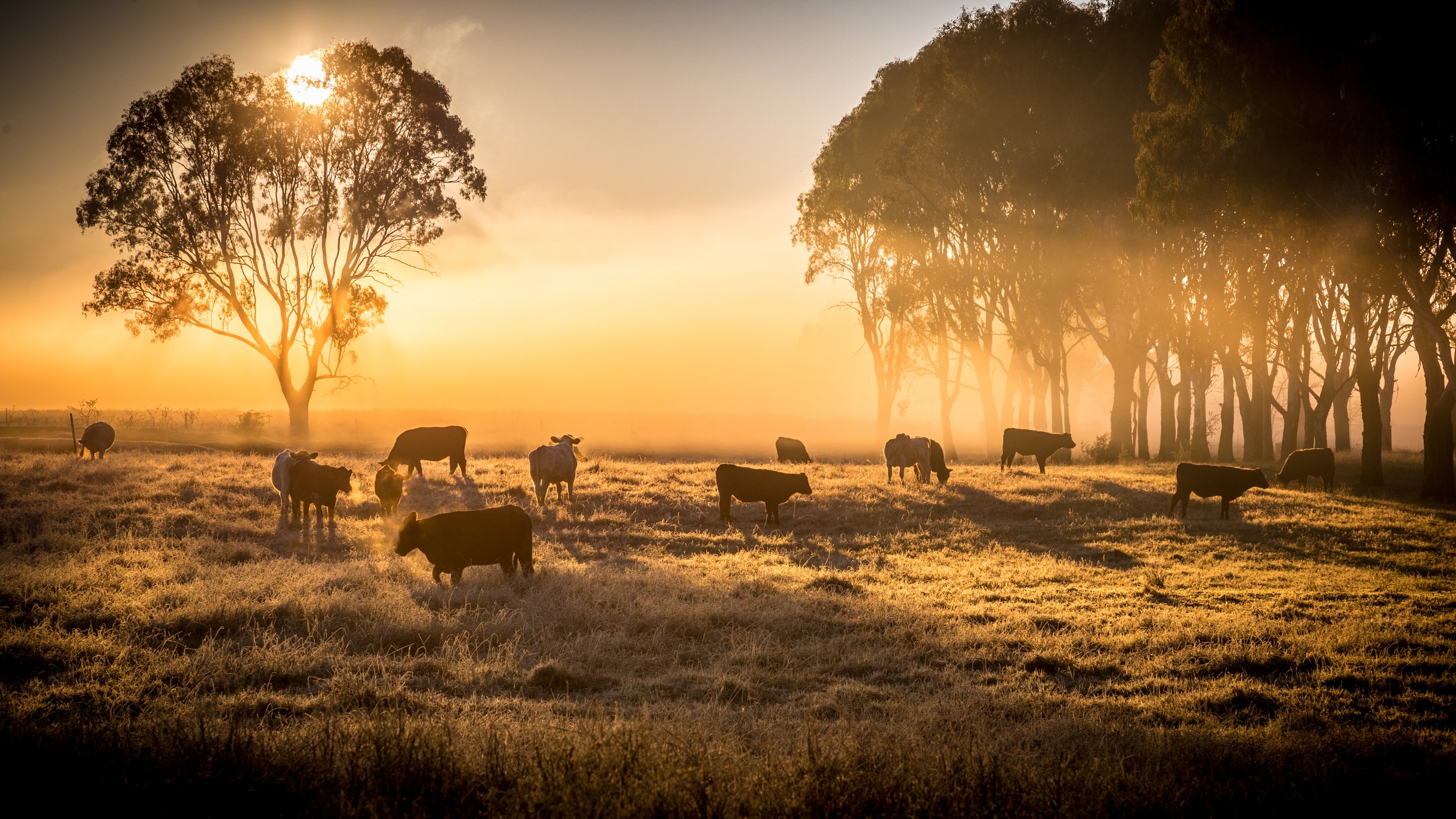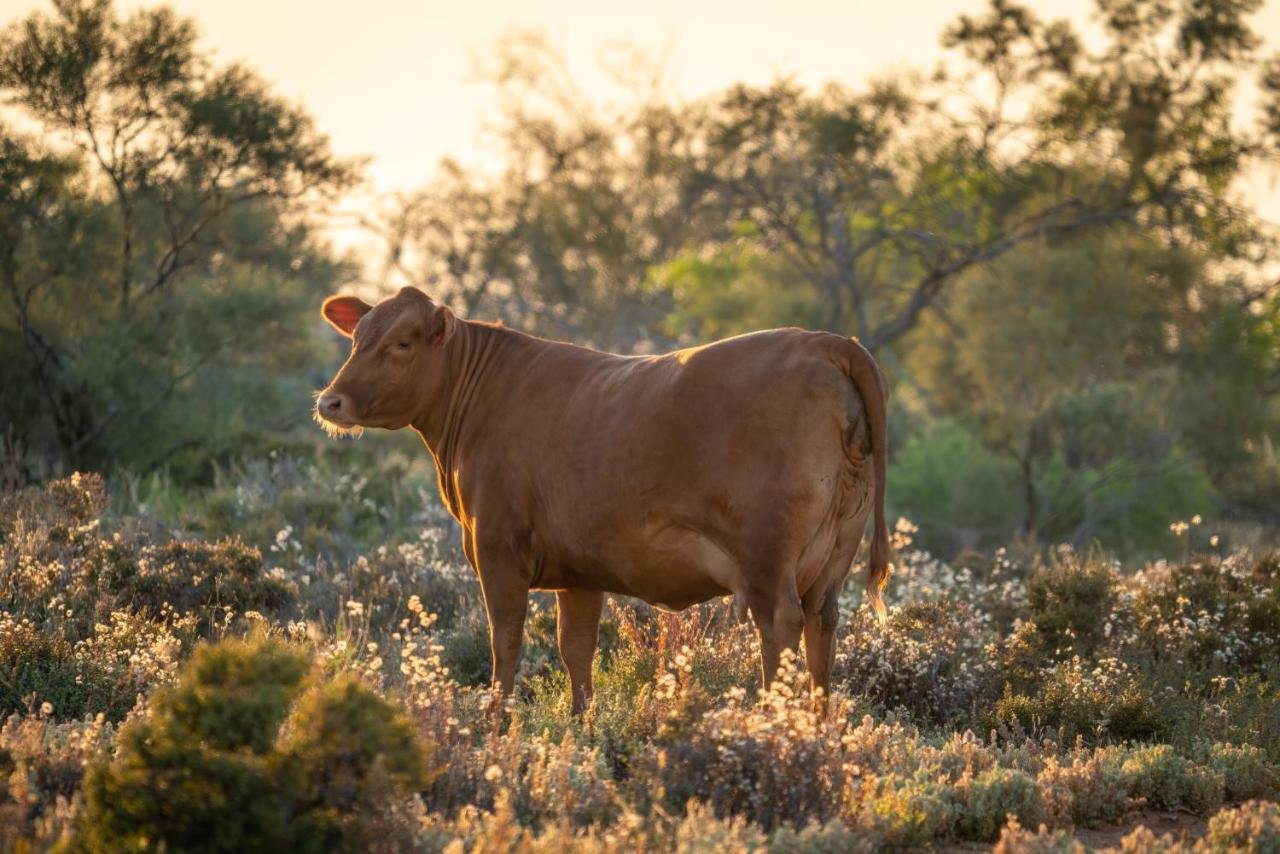
How can Dingoes
benefit cattle farmers?
Dingoes have been targeted with control programs since European arrival due to the widespread notion that dingoes impact producers through predation on livestock. Increasingly, cattle pastoralists are discovering the major economic and environmental advantages of maintaining dingoes on their properties through having the dingo control unmanaged grazing pressure.
Numerous cattle producers have found that dingoes significantly reduce the high-density populations of larger kangaroo species, as well as some feral animals including goats and pigs. Unmanaged grazing pressure has been consistently identified as a major factor contributing to reduced landscape quality across vast tracts of Australia’s rangelands.
It is important to consider whether the cost of dingo predation on livestock outweigh the potential benefits they bring to rangeland landscapes. Being relatively small canids (adults are between 15-17 kg in weight) dingoes are generally not successful predators of adult cattle, although they can prey on calves. In some cases, cows seem to provide protection of their calves from dingo attacks.
Dingoes vs wild dogs
Although some breeding with domestic dogs has occurred, recent genetic testing has demonstrated that the vast majority of wild canids killed across Australia are either entirely or mostly dingoes. Unlike cats and some other domesticated species, domestic dogs do not establish breeding feral populations in Australia. Of 5,039 DNA samples from wild canids across Australia, just 0.6% were found to be feral dogs.
In recent years, industry and some government bodies have deliberately stopped referring to the animals that are killed as ‘dingoes’ and instead refer to them as ‘wild dogs’. This label incorrectly suggests to the public and many graziers that dingoes are not being killed, but only feral domestic dogs, or hybrids between dingoes and dogs.
Image: Angus Emmott
Case studies:
Dingo Benefits in Action
Three commercial Australian beef producers have demonstrated the far reaching economical and environmental benefits of maintaining dingoes on cattle stations. Each property has varying business models, are widely separated geographically, and also differ in their ecological landscape. Each producer decided independently to cease dingo control, which was previously conducted on all three properties for more than 100 years.

Image: Wooleen Station
Wooleen Station, Murchison River district, Western Australia
152,000 hectare cattle property
Environment: The landscape is dominated by uncleared native vegetation, mostly mulga woodland, with chenopod shrublands along the Murchison and Roderick rivers, as well as some grasslands on ephemeral wetlands. Annual rainfall is 210 mm.
Background: Wooleen station run cattle, however prior to 2006 they ran sheep. For over 100 years, dingoes had been absent or near absent from Wooleen station due to lethal control. In 2007, dingoes began to reappear on Wooleen station and slowly increased in numbers between 2007-2010, from their arrival in 2007 the property managers did not kill the dingoes.
At the time when dingoes re-established on Wooleen, there was a large population of goats and kangaroos. Despite significant effort to control the number of grazing herbivores, owners of Wooleen believed that uncontrolled grazing from goats and kangaroos hindered their attempts to regenerate pasture that was in poor condition due to previous overgrazing. The consequences of the increase in dingoes on Wooleen station were dramatic.
Numerous observations regarding goats and kangaroos were made:
Feral goat numbers rapidly declined with the last commercial goat muster conducted in 2010 and the last goat sighting on the property was in 2014.
Kangaroo numbers were slower to decline, however it was estimated that the number of red kangaroos declined by 90% from their peak within 7 years of dingoes returning. Numbers of red kangaroos have remained consistently low since then, with minor seasonal fluctuations.
Image: Wooleen Station
The response from vegetation was also rapid:
Streamside tree species began to regenerate including river red gum, swamp she-oak and lesser bottlebrush. Prior to increased dingo numbers, there was virtually no vegetation of these species for a century due to grazing by feral goats, kangaroos and sheep.
In non-riverine areas notable improvements in regeneration were observed, especially species favoured by herbivores such as perennial grasses, saltbush and bluebushes.
Though sheep were removed from the property in 2006, substantial regeneration was only noted following the subsequent eradication of goats and reduction in kangaroo numbers. Resting paddocks from high densities of uncontrolled graziers became achievable, allowing for more appropriate grazing systems such as rotational grazing could be successfully implemented.
Close monitoring of the station's cattle population
has found no losses or damage due to dingo attacks.

Image: Claravale Station
Claravale Station,
Mitchell, Queensland
13,000 hectare cattle property
Environment: Claravale Station has valleys separated by sandstone ridges with considerable basalt capping. Poplar box is the dominant tree in the valleys, with some brigalow. All the valleys are cleared with substantial tree strips remaining for improved pasture quality. The ridges are mostly covered with lancewood, ironbark, native cypress and other acacia’s. The average rainfall in the area is 840mm.
Background: Dingoes were routinely controlled at Claravale until 1995, with around 20 dingoes caught annually. Despite the number of dingoes being controlled it is estimated that 10% of calves were either killed or injured. From the 1970’s, 1080 poison was utilised across the district and dingo populations collapsed. Subsequently, dingo populations recovered, presumably because some dingoes learnt to avoid baits.
A rapid expansion of large kangaroo populations was observed including eastern grey, red-necked wallaby and euro).
A previously established population of feral pigs expanded rapidly.
Feral goats, previously absent on Claravale station, also established.
At the time of dingo decline a number of changes were observed:
Feral goats were removed from the property.
Feral pigs were kept in low numbers
Kangaroo numbers remain low regardless of variations in seasonal conditions
These trends reversed when dingo control ceased in 1995:
Carcasses examined indicate dingoes main food source is young pigs, as well as very old and very young pigs. Calf losses from dingoes have fallen to 1-2%. Fewer numbers of kangaroos and feral animals allows for pasture to be fully rested when cattle are rotated around paddocks.
The station owner concluded that there was a connection between the stabilisation of dingo family groups, and durable reductions in the populations of native and feral herbivores.

Noonbah Station, Channel Country, Queensland
52,000 hectare cattle property
Environment: The landscape includes extensive treed and grassland floodplains on black soils of the Thomson River and Vergemont Creek, and mulga, gidyea and other woodland and shrublands on red-earths and laterites. It’s a semi-arid climate with 300mm of rainfall each year, but with fluctuating rainfall and erratic beneficial flooding events along the rivers.
Background: Dingoes stopped being controlled across Noonbah station in 2001, and stable dingo family groups quickly established.
A feral goat population of 100 animals (established from escapees from a neighboring property) were eliminated.
Feral pig populations noticeably decreased. In the 1990s mobs of over 100 pigs were observed on floodplains at Noonbah station and recreational hunters could shoot up to 100 animals a day. Today they are observed only in groups of less than 10.
Species of large kangaroos including eastern grey kangaroos, red kangaroos and euros have noticeably declined. Since ceasing control of dingoes, kangaroo populations have been consistently low through varying seasonal conditions.
When dingo control ceased, the positive impacts were several:
Consistently positive results
Each property has achieved similar outcomes by not controlling dingoes, most notably by reducing unmanaged grazing pressure. These changes did not correlate to climatic conditions, and all three properties had intervals of above and below average rainfall during the observed periods.
This resource was adapted from a CSIRO publishing ‘Can Dingoes increase graziers’ profits and help maintain Australia’s rangelands?’ Campbell G et al. (2022) The Rangeland Journal doi:10.107I/RJ22002

Image: Michelle J Photography








